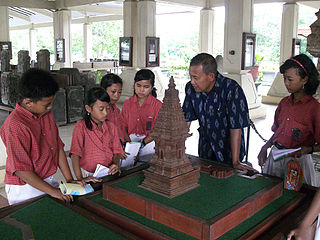
A salute is usually a formal hand gesture or other action used to display respect in military situations. Salutes are primarily associated with the military and law enforcement, but many civilian organizations, such as Girl Guides, Boy Scouts and the Salvation Army use formal salutes. Ordinary civilians also salute informally to greet or acknowledge the presence of another person, such as a tip of the hat or a hand wave to a friend or neighbour.

An insult is an expression, statement, or behavior that is often deliberately disrespectful, offensive, scornful, or derogatory towards an individual or a group. Insults can be intentional or unintentional, and they often aim to belittle, offend, or humiliate the target. While intentional insults can sometimes include factual information, they are typically presented in a pejorative manner, intended to provoke a negative emotional response or have a harmful reaction effect when used harmfully. Insults can also be made unintentionally or in a playful way but could in some cases also have negative impacts and effects even when they were not intended to insult.

Erving Goffman was a Canadian-born American sociologist, social psychologist, and writer, considered by some "the most influential American sociologist of the twentieth century".

Respect, also called esteem, is a positive feeling or deferential action shown towards someone or something considered important or held in high esteem or regard. It conveys a sense of admiration for good or valuable qualities. It is also the process of honoring someone by exhibiting care, concern, or consideration for their needs or feelings.

A gesture is a form of non-verbal communication or non-vocal communication in which visible bodily actions communicate particular messages, either in place of, or in conjunction with, speech. Gestures include movement of the hands, face, or other parts of the body. Gestures differ from physical non-verbal communication that does not communicate specific messages, such as purely expressive displays, proxemics, or displays of joint attention. Gestures allow individuals to communicate a variety of feelings and thoughts, from contempt and hostility to approval and affection, often together with body language in addition to words when they speak. Gesticulation and speech work independently of each other, but join to provide emphasis and meaning.

Greeting is an act of communication in which human beings intentionally make their presence known to each other, to show attention to, and to suggest a type of relationship or social status between individuals or groups of people coming in contact with each other. Greetings are sometimes used just prior to a conversation or to greet in passing, such as on a sidewalk or trail. While greeting customs are highly culture- and situation-specific and may change within a culture depending on social status and relationship, they exist in all known human cultures. Greetings can be expressed both audibly and physically, and often involve a combination of the two. This topic excludes military and ceremonial salutes but includes rituals other than gestures. A greeting, or salutation, can also be expressed in written communications, such as letters and emails.

Cheek kissing is a ritual or social kissing gesture to indicate friendship, family relationship, perform a greeting, to confer congratulations, to comfort someone, or to show respect.
Impression management is a conscious or subconscious process in which people attempt to influence the perceptions of other people about a person, object or event by regulating and controlling information in social interaction. It was first conceptualized by Erving Goffman in 1959 in The Presentation of Self in Everyday Life, and then was expanded upon in 1967.

Dramaturgy is a sociological perspective that analyzes micro-sociological accounts of everyday social interactions through the analogy of performativity and theatrical dramaturgy, dividing such interactions between "actors", "audience" members, and various "front" and "back" stages.

Etiquette in Asia varies from country to country even though certain actions may seem to be common. No article on the rules of etiquette, nor any list of faux pas, can ever be complete. As the perception of behaviors and actions vary, intercultural competence is essential. A lack of knowledge about the customs and expectations of Asian people can make even those with good intentions seem rude, foolish, and disrespectful.
Etiquette in Europe is not uniform. Even within the regions of Europe, etiquette may not be uniform: within a single country there may be differences in customs, especially where there are different linguistic groups, as in Switzerland where there are French, German and Italian speakers.
Etiquette in Latin America varies by country and by region within a given country.

Sembah is an Indonesian greeting and gesture of respect and reverence. While performing the sembah, one clasps their palms together solemnly in a prayer-like fashion called suhun or susuhun in Javanese; or menyusun jari sepuluh in Indonesian and Malay, placing them in front of their chest and moving the pressed palms up to their chin, or all the way up until their thumbs touch the tip of their nose, while bowing slightly. Any of these two forms are made depending on the status of the person greeted.
Etiquette in technology, colloquially referred to as netiquette, is a term used to refer to the unofficial code of policies that encourage good behavior on the Internet which is used to regulate respect and polite behavior on social media platforms, online chatting sites, web forums, and other online engagement websites. The rules of etiquette that apply when communicating over the Internet are different from these applied when communicating in person or by audio or photographic phone. It is a social code that is used in all places where one can interact with other human beings via the Internet, including text messaging, email, online games, Internet forums, chat rooms, and many more. Although social etiquette in real life is ingrained into our social life, netiquette is a fairly recent concept.

Traditions of Indonesia are traditions, beliefs, values, and customs that belong within the culture of Indonesian people. Indonesia is a vast country of sprawling archipelago with a diverse demographic range of over 1,300 ethnic groups, and speaking more than 700 living languages.

Various codes of etiquette in Indonesia govern the expectations of social behavior in the country and are considered very important. Etiquette demonstrates respect and is a key factor in social interactions. Like many social cultures, etiquette varies greatly depending on one's status relative to the person in question. Some conventions may be region-specific, and thus may not exist in all regions of Indonesia. The following are generally accepted contemporary customs in Indonesia.

Waving is a nonverbal communication gesture that consists of the movement of the hand and/or entire arm that people commonly use to greet each other, but it can also be used to say goodbye, acknowledge another's presence, call for silence, or deny someone. The wave gesture is an essential element of human language.

Tie signs are signs, signals, and symbols, that are revealed through people's actions as well as objects such as engagement rings, wedding bands, and photographs of a personal nature that suggest a relationship exists between two people. For romantic couples, public displays of affection (PDA) including things like holding hands, an arm around a partner's shoulders or waist, extended periods of physical contact, greater-than-normal levels of physical proximity, grooming one's partner, and “sweet talk” are all examples of common tie signs. Tie signs inform the participants, as well as outsiders, about the nature of a relationship, its condition, and even what stage a relationship is in.

The Fist-and-palm gesture, also known as Gongshou, or Zuoyi in Chinese, is a traditional Chinese ceremonial gesture or salute used for greeting or showing respect. It involves bringing together the index finger, middle finger, ring finger, and little finger of both hands, with the palms facing inward or downward and the thumbs of each hand interlocking. One hand is placed over the other, and generally, the left-hand covers the right one for men and is reversed for women. There are different variants depending on conditions, such as gender, occasion and relationship between the individuals. Additional hand and body movements such as bowing may be used with the gesture.
















